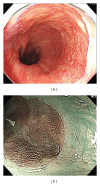Differences in the Characteristics of Barrett's Esophagus and Barrett's Adenocarcinoma between the United States and Japan
- PMID: 23606979
- PMCID: PMC3625601
- DOI: 10.1155/2013/840690
Differences in the Characteristics of Barrett's Esophagus and Barrett's Adenocarcinoma between the United States and Japan
Abstract
In Europe and the United States, the incidence of esophageal adenocarcinoma has increased 6-fold in the last 25 years and currently accounts for more than 50% of all esophageal cancers. Barrett's esophagus is the source of Barrett's adenocarcinoma and is characterized by the replacement of squamous epithelium with columnar epithelium in the lower esophagus due to chronic gastroesophageal reflux disease (GERD). Even though the prevalence of GERD has recently been increasing in Japan as well as in Europe and the United States, the clinical situation of Barrett's esophagus and Barrett's adenocarcinoma differs from that in Western countries. In this paper, we focus on specific differences in the background factors and pathophysiology of these lesions.
Figures




Similar articles
-
The Present Status and Future of Barrett's Esophageal Adenocarcinoma in Japan.Digestion. 2019;99(2):185-190. doi: 10.1159/000490508. Epub 2018 Nov 27. Digestion. 2019. PMID: 30481763 Review.
-
LOW PREVALENCE OF BARRETT'S ESOPHAGUS IN A RISK AREA FOR ESOPHAGEAL CANCER IN SOUTH OF BRAZIL.Arq Gastroenterol. 2017 Dec;54(4):305-307. doi: 10.1590/S0004-2803.201700000-45. Epub 2017 Sep 21. Arq Gastroenterol. 2017. PMID: 28954045
-
From GERD to Barrett's esophagus: is the pattern in Asia mirroring that in the West?J Gastroenterol Hepatol. 2011 May;26(5):816-24. doi: 10.1111/j.1440-1746.2011.06669.x. J Gastroenterol Hepatol. 2011. PMID: 21265879
-
Origins of Metaplasia in Barrett's Esophagus: Is this an Esophageal Stem or Progenitor Cell Disease?Dig Dis Sci. 2018 Aug;63(8):2005-2012. doi: 10.1007/s10620-018-5069-5. Dig Dis Sci. 2018. PMID: 29675663 Free PMC article. Review.
-
Differential response to preoperative chemoradiation and surgery in esophageal adenocarcinomas based on presence of Barrett's esophagus and symptomatic gastroesophageal reflux.Ann Thorac Surg. 2005 May;79(5):1716-23. doi: 10.1016/j.athoracsur.2004.10.026. Ann Thorac Surg. 2005. PMID: 15854962
Cited by
-
Definition of Barrett's esophagus dysplasia: are we speaking the same language?World J Surg. 2015 Mar;39(3):559-65. doi: 10.1007/s00268-014-2692-y. World J Surg. 2015. PMID: 25015727
References
-
- Cameron AJ. Epidemiology of Barrett’s esophagus and adenocarcinoma. Diseases of the Esophagus . 2002;15:106–108. - PubMed
-
- Hongo M, Shoji T. Epidemiology of reflex disease and CLE in East Asia. Journal of Gastroenterology. 2003;38:25–30. - PubMed
-
- Sampliner RE. Practice guidelines on diagnosis, surveillance, and therapy of Barrett’s esophagus. The American Journal of Gastroenterology. 1998;93:1028–1032. - PubMed
-
- Vieth M, Aida J, Takubo K. Cardiac rather than intestinal-type background in endoscopic resection specimens of minute Barrett adenocarcinoma-reply. Human Pathology. 2009;40(8):1209–1210. - PubMed
LinkOut - more resources
Full Text Sources
Other Literature Sources
